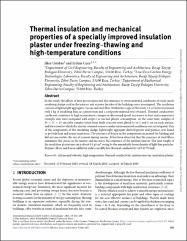| dc.contributor.author | Ustabaş, İlker | |
| dc.contributor.author | Cüce, Erdem | |
| dc.date.accessioned | 2023-08-18T07:19:14Z | |
| dc.date.available | 2023-08-18T07:19:14Z | |
| dc.date.issued | 2023 | en_US |
| dc.identifier.citation | Ustabaş, İ. & Cüce, E. (2023). Thermal insulation and mechanical properties of a specially improved insulation plaster under freezing-thawing and high-temperature conditions. International Journal of Low-Carbon Technologies, 18, 682-688. https://doi.org/10.1093/ijlct/ctad034 | en_US |
| dc.identifier.issn | 1748-1317 | |
| dc.identifier.issn | 1748-1325 | |
| dc.identifier.uri | https://doi.org/10.1093/ijlct/ctad034 | |
| dc.identifier.uri | https://hdl.handle.net/11436/8062 | |
| dc.description.abstract | In this study, the effects of heat preservation and the resistance to environmental conditions of ready-made insulating sludge used in the interior and exterior facades of the buildings were investigated. The insulation consists of lightweight aggregates, boron and steel fiber. Within the scope of the study, 1 L of water was mixed with 1 kg of insulating fluid as a proportion and a composite material was obtained. Thermal conductivity coefficient, resistance to high temperature, changes in ultrasound speed, resistance to frost and compressive strength tests were compared with respect to normal plaster consumption. At the same time, samples of 15 x 15 x 15 cm cube samples taken from fresh concrete were plated to be 1 and 2 cm on each surface, and the extent to which the mortar retained concrete under environmental conditions was investigated. One of the components of the insulating sludge, lightweight aggregate-derived perlite and pumice, was found to provide heat and sound insulation. The presence of boron in the components increased the binding and did not necessitate the use of cement during mortar. It has been observed that the presence of steel fibers minimizes the cracks in the mortar and increases the resistance of the mixture mortar. The unit weight of the insulation plaster mortar is about 0.5 g/cm(3) owing to the remarkably lower density of light fine particles. Polymer fibers and boron additives yield a notably low thermal conductivity of 0.13 W/mK. | en_US |
| dc.language.iso | eng | en_US |
| dc.publisher | Oxford University Press | en_US |
| dc.rights | info:eu-repo/semantics/openAccess | en_US |
| dc.subject | Ultrasound velocity | en_US |
| dc.subject | High temperature | en_US |
| dc.subject | Thermal conductivity | en_US |
| dc.subject | Mixture mortar | en_US |
| dc.subject | Insulation plaster | en_US |
| dc.title | Thermal insulation and mechanical properties of a specially improved insulation plaster under freezing-thawing and high-temperature conditions | en_US |
| dc.type | article | en_US |
| dc.contributor.department | RTEÜ, Mühendislik ve Mimarlık Fakültesi, İnşaat Mühendisliği Bölümü | en_US |
| dc.contributor.institutionauthor | Ustabaş, İlker | |
| dc.contributor.institutionauthor | Cüce, Erdem | |
| dc.identifier.doi | 10.1093/ijlct/ctad034 | en_US |
| dc.identifier.volume | 18 | en_US |
| dc.identifier.startpage | 682 | en_US |
| dc.identifier.endpage | 688 | en_US |
| dc.relation.journal | International Journal of Low-Carbon Technologies | en_US |
| dc.relation.publicationcategory | Makale - Uluslararası Hakemli Dergi - Kurum Öğretim Elemanı | en_US |


















